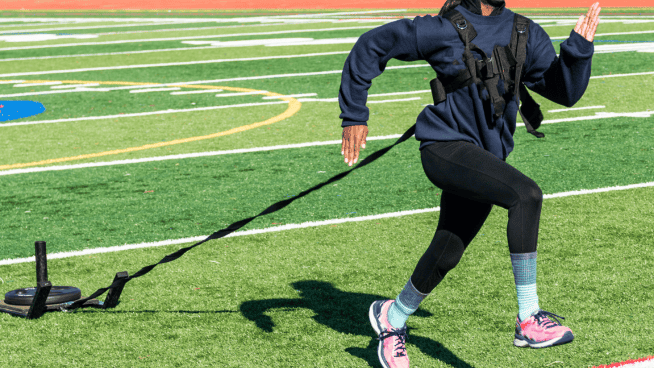The Differences Between Strength and Power Training
The quest for the perfect combination of strength and power has long puzzled athletes and weightlifters. Although the two share similar qualities, they actually have some subtle differences. Knowing and understanding these differences can help athletes identify the most important attributes for their sport and gear their training accordingly.
To fully appreciate the differences between strength and power, we must first understand the force-velocity relationship. This concept, although it sounds complicated, is actually quite simple. In its most basic form, power is the relationship of force, distance and time expressed in the following formula:
Power = (Force x Distance) / Time
Training for Strength
Traditional strength training alters the first variable in this equation by increasing an athlete’s ability to apply a maximum amount of force. The ultimate goal is to increase the amount of weight you can lift for a single repetition (referred to as one rep max or 1RM). Speed of lifting doesn’t matter. In fact, under a heavy load, you won’t be able to move the weight quickly.
To increase maximum force generation—and thus their overall strength—athletes should use heavy loads for numerous sets of three to six repetitions. The best exercises are those that allow for heavier loading, typically multi-joint exercises like the Squat, Deadlift, and Bench Press. Learn how to build your own strength training program.
Training for Power
Unlike training solely for strength, training for maximum power engages the time element. The main focus of this type of training is to reduce the amount of time it takes to apply a set amount of force. As the speed of movement increases, force decreases. Therefore, the goal is to find the right load, one that allows quick movement while also generating a large amount of force. Maximum power is generated at intermediate velocities when lifting moderate loads. (3,4)
The relationship between force and velocity explains why an athlete can be exceptionally strong but lack significant power. Power lies in the ability to produce force quickly. If an athlete is really strong but produces maximum force slowly, s/he will lack power. In this scenario, athletes would benefit from increasing their rate of force production or their ability to apply force quickly. Learn more about power training.
Increasing Rate of Force Production Through Power Training
Once an athlete has established a solid foundation for training, heavy strength training can initially improve his or her rate of force production by positively affecting the first half of the power equation, or peak force production. (6,7,8) However, at a certain level, many athletes need to focus solely on power training to continually improve. In fact, among seasoned veterans, simply focusing on lifting heavy weights could be counterproductive. In one study, lifting weights of 70-100% 1RM was shown to reduce the rate of force production, which is detrimental to power development. (9) This helps to explain why heavy resistance training is less effective at increasing vertical jump performance compared to ballistics or plyometrics in strength-trained individuals. (8,10,11) Instead of relying solely on heavy strength training, incorporate two of the methods below to increase your rate of force production and boost your power as a result.
1. Explosive Strength Training
In this scenario, athletes can use free weights with loads of 75-85% for sets of three to five repetitions. (1,5,8) For example, athletes could incorporate Power Cleans and Power Snatches into their routines. Sets are not performed to exhaustion. The quality and speed of each lift are more important. Rest intervals are also kept high for the same reason.
Explosive strength training can be tailored to the individual user. For athletes participating in single-effort sports such as throwing events, a higher load (80-90% of 1RM) can be used for a smaller number of repetitions (1-2). A multiple-effort athlete, e.g., a sprinter, would benefit from a slightly lower load and higher repetitions.
2. Plyometrics
Plyometric drills involve quick, powerful movements using a pre-stretch or counter-movement that involves the stretch shortening cycle. (1) Classical plyometric exercises include various types of jump training and upper body drills using medicine balls. Plyometrics teach athletes to absorb and create force rapidly, making them crucial for improving performance and preventing injury during competition. (Check out STACK’s Plyometrics page for plyo exercises you can incorporate into your workout.)
What’s the Best Form of Power Training?
The type of power training you use should be specific to your sport or event. Olympic lifts, such as Power Cleans, are suitable for sports such as football and rugby. Plyometric exercises are more suitable for soccer and hockey. Ballistic exercises with medicine balls fit well with basketball and volleyball.
Although the most beneficial form of power training varies by sport, increasing your rate of force production is crucial to improving your overall athletic performance. Remember that maximal strength training only goes so far in terms of increasing power production. Athletes must be strong to compete at an elite level, but they also must be able to produce force quickly. Examine the demands of your sport and incorporate appropriate drills to boost your rate of force production and directly improve your performance on the field or court.
References
1) Baechle TR and Earle RW. (2000) Essentials of Strength Training and Conditioning: 2nd Edition. Champaign, IL: Human Kinetics.
2) Bompa TO. 1999 Periodization Training for Sports. Champaign, IL: Human Kinetics.
3) Knuttgen HG and Kraemer WJ. “Terminology and measurement in exercise performance.” Journal of Applied Sport Science Research. 1987 1:1-10.
4) Newton RU, Murphy AJ, Humphries BJ, Wilson GJ, Kraemer WJ, Hakkinen K. “Influence of load and stretch shortening cycle on the kinematics, kinetics and muscle activation that occurs during explosive upper-body movements.” European Journal of Applied Physiology.1997;75(4):333-42.
5) Garhammer J. “A review of power output studies of Olympic and powerlifting: Methedology, performance prediction and evaluation tests.” Journal of Strength and Conditioning Research. 1993 7(2):76-89.
6) Adams K, O’Shea JP, O’Shea KL and Climstein M. “The effect of six weeks of squat, plyometric and squat-plyometric training on power production.” Journal of Applied Sport Science Research. 1992 6:36-41.
7) Clutch D, Wilson C, McGown C and Bryce GR. “The effect of depth jumps and weight training on leg strength and vertical jump.” Research Quarterly. 54:5-10.
8) Wilson GJ, Newton RU, Murphy AJ, Humphries BJ. “The optimal training load for the development of dynamic athletic performance.” Medicine and Science of Sports and Exercise. 1993 Nov;25(11):1279-86.
9) Behm DG, Sale DG. “Velocity specificity of resistance training.” Sports Medicine. 1993 Jun;15(6):374-88.
10) Hakkinen K and Komi PV. “Changes in electrical and mechanical behavior of leg extensor muscles during heavy resistance strength training.” Scandinavian Journal of Sports Science. 1985 55-64.
11) Berger RA. “Effects of dynamic and static training on vertical jump ability.” Research Quarterly 34: 419-424
RECOMMENDED FOR YOU
MOST POPULAR
The Differences Between Strength and Power Training
The quest for the perfect combination of strength and power has long puzzled athletes and weightlifters. Although the two share similar qualities, they actually have some subtle differences. Knowing and understanding these differences can help athletes identify the most important attributes for their sport and gear their training accordingly.
To fully appreciate the differences between strength and power, we must first understand the force-velocity relationship. This concept, although it sounds complicated, is actually quite simple. In its most basic form, power is the relationship of force, distance and time expressed in the following formula:
Power = (Force x Distance) / Time
Training for Strength
Traditional strength training alters the first variable in this equation by increasing an athlete’s ability to apply a maximum amount of force. The ultimate goal is to increase the amount of weight you can lift for a single repetition (referred to as one rep max or 1RM). Speed of lifting doesn’t matter. In fact, under a heavy load, you won’t be able to move the weight quickly.
To increase maximum force generation—and thus their overall strength—athletes should use heavy loads for numerous sets of three to six repetitions. The best exercises are those that allow for heavier loading, typically multi-joint exercises like the Squat, Deadlift, and Bench Press. Learn how to build your own strength training program.
Training for Power
Unlike training solely for strength, training for maximum power engages the time element. The main focus of this type of training is to reduce the amount of time it takes to apply a set amount of force. As the speed of movement increases, force decreases. Therefore, the goal is to find the right load, one that allows quick movement while also generating a large amount of force. Maximum power is generated at intermediate velocities when lifting moderate loads. (3,4)
The relationship between force and velocity explains why an athlete can be exceptionally strong but lack significant power. Power lies in the ability to produce force quickly. If an athlete is really strong but produces maximum force slowly, s/he will lack power. In this scenario, athletes would benefit from increasing their rate of force production or their ability to apply force quickly. Learn more about power training.
Increasing Rate of Force Production Through Power Training
Once an athlete has established a solid foundation for training, heavy strength training can initially improve his or her rate of force production by positively affecting the first half of the power equation, or peak force production. (6,7,8) However, at a certain level, many athletes need to focus solely on power training to continually improve. In fact, among seasoned veterans, simply focusing on lifting heavy weights could be counterproductive. In one study, lifting weights of 70-100% 1RM was shown to reduce the rate of force production, which is detrimental to power development. (9) This helps to explain why heavy resistance training is less effective at increasing vertical jump performance compared to ballistics or plyometrics in strength-trained individuals. (8,10,11) Instead of relying solely on heavy strength training, incorporate two of the methods below to increase your rate of force production and boost your power as a result.
1. Explosive Strength Training
In this scenario, athletes can use free weights with loads of 75-85% for sets of three to five repetitions. (1,5,8) For example, athletes could incorporate Power Cleans and Power Snatches into their routines. Sets are not performed to exhaustion. The quality and speed of each lift are more important. Rest intervals are also kept high for the same reason.
Explosive strength training can be tailored to the individual user. For athletes participating in single-effort sports such as throwing events, a higher load (80-90% of 1RM) can be used for a smaller number of repetitions (1-2). A multiple-effort athlete, e.g., a sprinter, would benefit from a slightly lower load and higher repetitions.
2. Plyometrics
Plyometric drills involve quick, powerful movements using a pre-stretch or counter-movement that involves the stretch shortening cycle. (1) Classical plyometric exercises include various types of jump training and upper body drills using medicine balls. Plyometrics teach athletes to absorb and create force rapidly, making them crucial for improving performance and preventing injury during competition. (Check out STACK’s Plyometrics page for plyo exercises you can incorporate into your workout.)
What’s the Best Form of Power Training?
The type of power training you use should be specific to your sport or event. Olympic lifts, such as Power Cleans, are suitable for sports such as football and rugby. Plyometric exercises are more suitable for soccer and hockey. Ballistic exercises with medicine balls fit well with basketball and volleyball.
Although the most beneficial form of power training varies by sport, increasing your rate of force production is crucial to improving your overall athletic performance. Remember that maximal strength training only goes so far in terms of increasing power production. Athletes must be strong to compete at an elite level, but they also must be able to produce force quickly. Examine the demands of your sport and incorporate appropriate drills to boost your rate of force production and directly improve your performance on the field or court.
References
1) Baechle TR and Earle RW. (2000) Essentials of Strength Training and Conditioning: 2nd Edition. Champaign, IL: Human Kinetics.
2) Bompa TO. 1999 Periodization Training for Sports. Champaign, IL: Human Kinetics.
3) Knuttgen HG and Kraemer WJ. “Terminology and measurement in exercise performance.” Journal of Applied Sport Science Research. 1987 1:1-10.
4) Newton RU, Murphy AJ, Humphries BJ, Wilson GJ, Kraemer WJ, Hakkinen K. “Influence of load and stretch shortening cycle on the kinematics, kinetics and muscle activation that occurs during explosive upper-body movements.” European Journal of Applied Physiology.1997;75(4):333-42.
5) Garhammer J. “A review of power output studies of Olympic and powerlifting: Methedology, performance prediction and evaluation tests.” Journal of Strength and Conditioning Research. 1993 7(2):76-89.
6) Adams K, O’Shea JP, O’Shea KL and Climstein M. “The effect of six weeks of squat, plyometric and squat-plyometric training on power production.” Journal of Applied Sport Science Research. 1992 6:36-41.
7) Clutch D, Wilson C, McGown C and Bryce GR. “The effect of depth jumps and weight training on leg strength and vertical jump.” Research Quarterly. 54:5-10.
8) Wilson GJ, Newton RU, Murphy AJ, Humphries BJ. “The optimal training load for the development of dynamic athletic performance.” Medicine and Science of Sports and Exercise. 1993 Nov;25(11):1279-86.
9) Behm DG, Sale DG. “Velocity specificity of resistance training.” Sports Medicine. 1993 Jun;15(6):374-88.
10) Hakkinen K and Komi PV. “Changes in electrical and mechanical behavior of leg extensor muscles during heavy resistance strength training.” Scandinavian Journal of Sports Science. 1985 55-64.
11) Berger RA. “Effects of dynamic and static training on vertical jump ability.” Research Quarterly 34: 419-424











